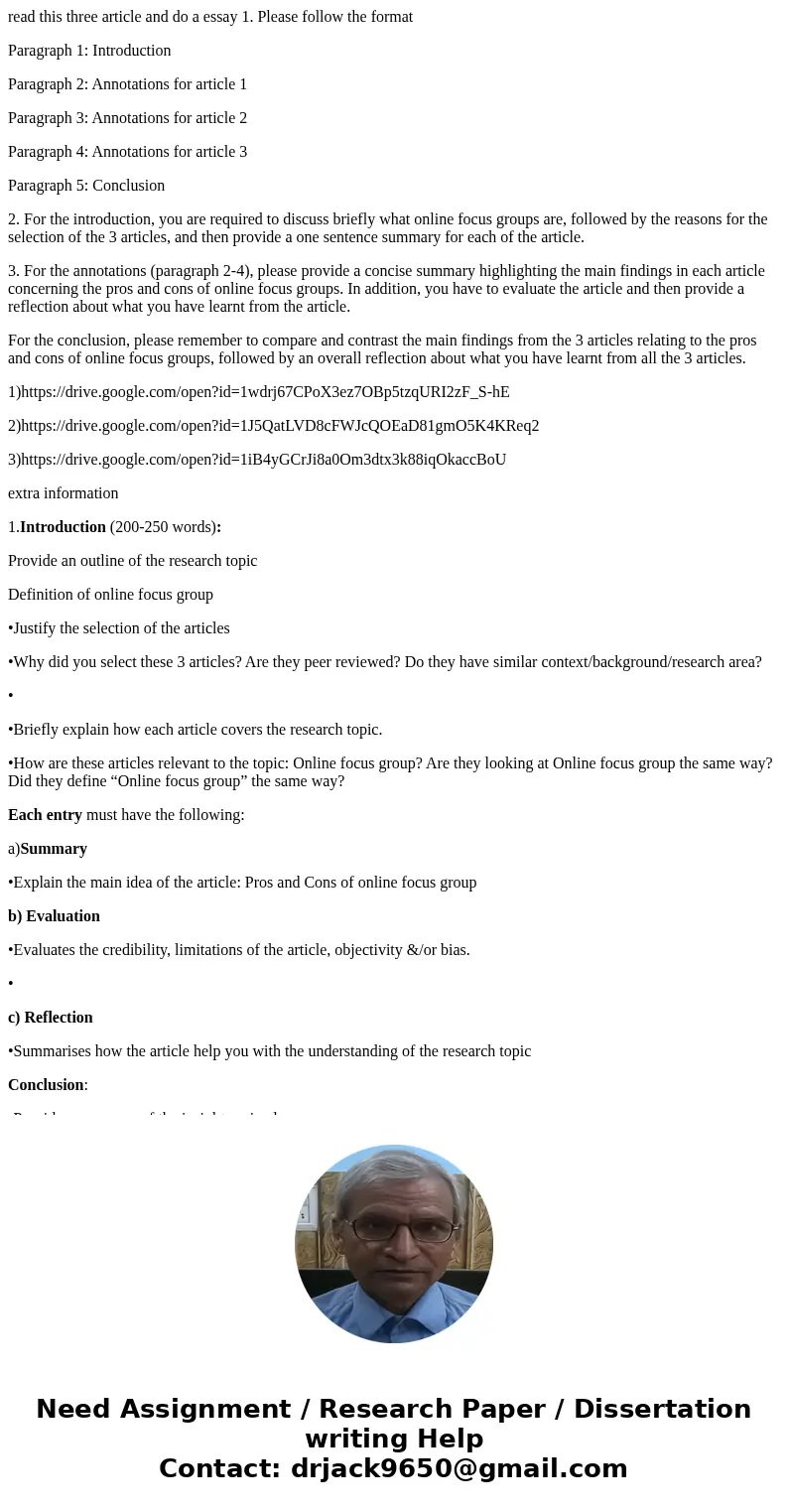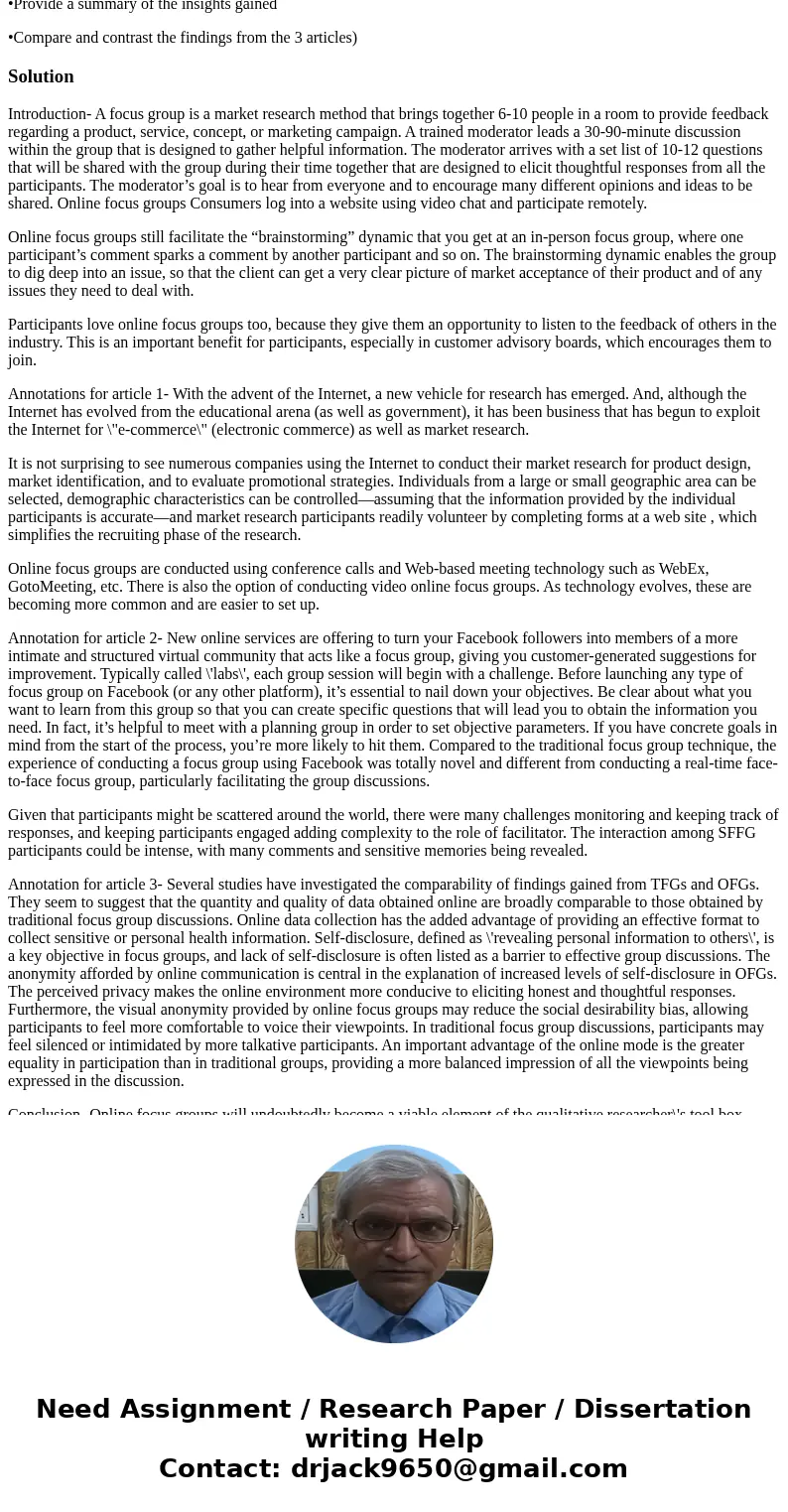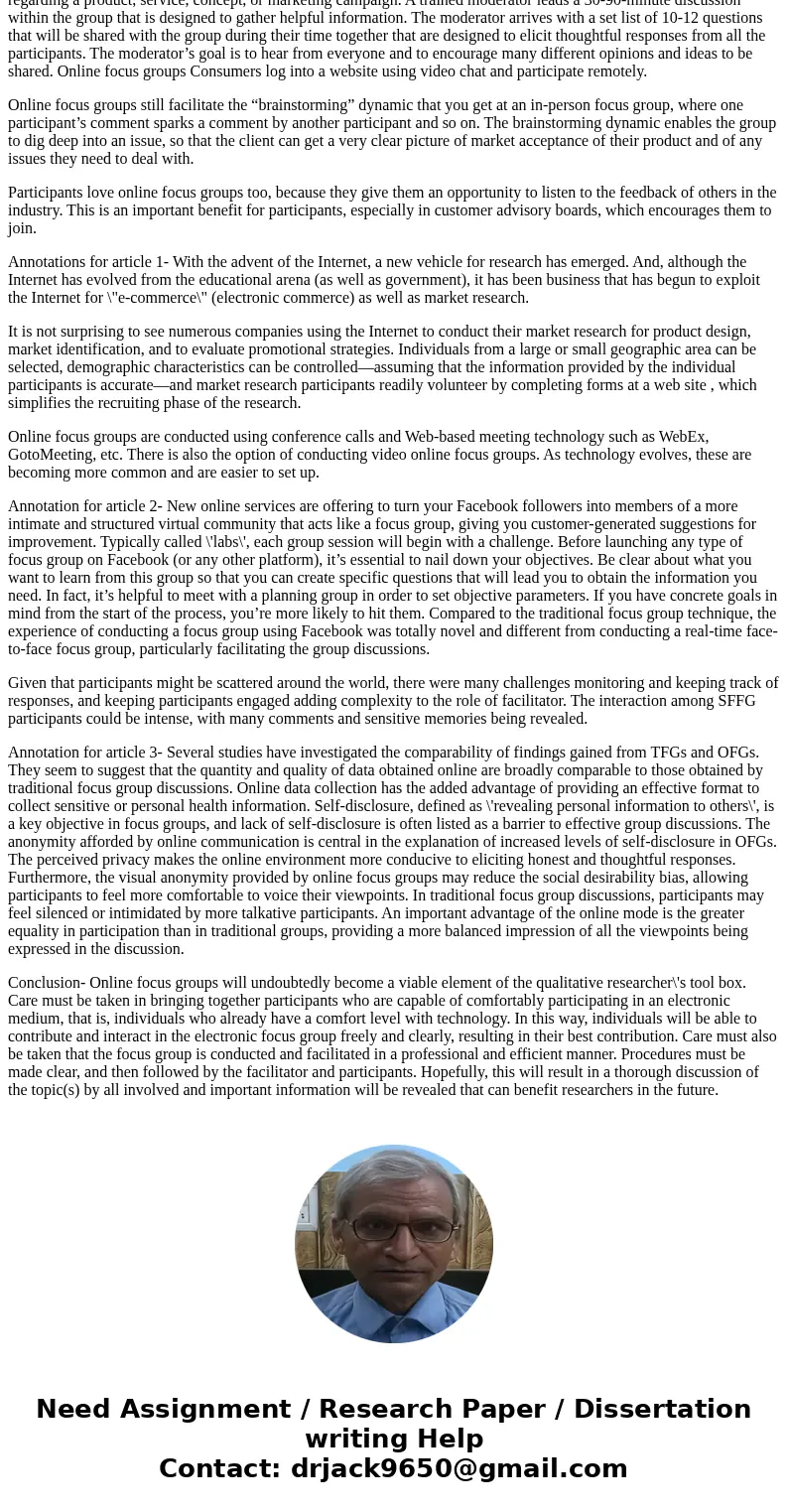read this three article and do a essay 1 Please follow the f
read this three article and do a essay 1. Please follow the format
Paragraph 1: Introduction
Paragraph 2: Annotations for article 1
Paragraph 3: Annotations for article 2
Paragraph 4: Annotations for article 3
Paragraph 5: Conclusion
2. For the introduction, you are required to discuss briefly what online focus groups are, followed by the reasons for the selection of the 3 articles, and then provide a one sentence summary for each of the article.
3. For the annotations (paragraph 2-4), please provide a concise summary highlighting the main findings in each article concerning the pros and cons of online focus groups. In addition, you have to evaluate the article and then provide a reflection about what you have learnt from the article.
For the conclusion, please remember to compare and contrast the main findings from the 3 articles relating to the pros and cons of online focus groups, followed by an overall reflection about what you have learnt from all the 3 articles.
1)https://drive.google.com/open?id=1wdrj67CPoX3ez7OBp5tzqURI2zF_S-hE
2)https://drive.google.com/open?id=1J5QatLVD8cFWJcQOEaD81gmO5K4KReq2
3)https://drive.google.com/open?id=1iB4yGCrJi8a0Om3dtx3k88iqOkaccBoU
extra information
1.Introduction (200-250 words):
Provide an outline of the research topic
Definition of online focus group
•Justify the selection of the articles
•Why did you select these 3 articles? Are they peer reviewed? Do they have similar context/background/research area?
•
•Briefly explain how each article covers the research topic.
•How are these articles relevant to the topic: Online focus group? Are they looking at Online focus group the same way? Did they define “Online focus group” the same way?
Each entry must have the following:
a)Summary
•Explain the main idea of the article: Pros and Cons of online focus group
b) Evaluation
•Evaluates the credibility, limitations of the article, objectivity &/or bias.
•
c) Reflection
•Summarises how the article help you with the understanding of the research topic
Conclusion:
•Provide a summary of the insights gained
•Compare and contrast the findings from the 3 articles)
Solution
Introduction- A focus group is a market research method that brings together 6-10 people in a room to provide feedback regarding a product, service, concept, or marketing campaign. A trained moderator leads a 30-90-minute discussion within the group that is designed to gather helpful information. The moderator arrives with a set list of 10-12 questions that will be shared with the group during their time together that are designed to elicit thoughtful responses from all the participants. The moderator’s goal is to hear from everyone and to encourage many different opinions and ideas to be shared. Online focus groups Consumers log into a website using video chat and participate remotely.
Online focus groups still facilitate the “brainstorming” dynamic that you get at an in-person focus group, where one participant’s comment sparks a comment by another participant and so on. The brainstorming dynamic enables the group to dig deep into an issue, so that the client can get a very clear picture of market acceptance of their product and of any issues they need to deal with.
Participants love online focus groups too, because they give them an opportunity to listen to the feedback of others in the industry. This is an important benefit for participants, especially in customer advisory boards, which encourages them to join.
Annotations for article 1- With the advent of the Internet, a new vehicle for research has emerged. And, although the Internet has evolved from the educational arena (as well as government), it has been business that has begun to exploit the Internet for \"e-commerce\" (electronic commerce) as well as market research.
It is not surprising to see numerous companies using the Internet to conduct their market research for product design, market identification, and to evaluate promotional strategies. Individuals from a large or small geographic area can be selected, demographic characteristics can be controlled—assuming that the information provided by the individual participants is accurate—and market research participants readily volunteer by completing forms at a web site , which simplifies the recruiting phase of the research.
Online focus groups are conducted using conference calls and Web-based meeting technology such as WebEx, GotoMeeting, etc. There is also the option of conducting video online focus groups. As technology evolves, these are becoming more common and are easier to set up.
Annotation for article 2- New online services are offering to turn your Facebook followers into members of a more intimate and structured virtual community that acts like a focus group, giving you customer-generated suggestions for improvement. Typically called \'labs\', each group session will begin with a challenge. Before launching any type of focus group on Facebook (or any other platform), it’s essential to nail down your objectives. Be clear about what you want to learn from this group so that you can create specific questions that will lead you to obtain the information you need. In fact, it’s helpful to meet with a planning group in order to set objective parameters. If you have concrete goals in mind from the start of the process, you’re more likely to hit them. Compared to the traditional focus group technique, the experience of conducting a focus group using Facebook was totally novel and different from conducting a real-time face-to-face focus group, particularly facilitating the group discussions.
Given that participants might be scattered around the world, there were many challenges monitoring and keeping track of responses, and keeping participants engaged adding complexity to the role of facilitator. The interaction among SFFG participants could be intense, with many comments and sensitive memories being revealed.
Annotation for article 3- Several studies have investigated the comparability of findings gained from TFGs and OFGs. They seem to suggest that the quantity and quality of data obtained online are broadly comparable to those obtained by traditional focus group discussions. Online data collection has the added advantage of providing an effective format to collect sensitive or personal health information. Self-disclosure, defined as \'revealing personal information to others\', is a key objective in focus groups, and lack of self-disclosure is often listed as a barrier to effective group discussions. The anonymity afforded by online communication is central in the explanation of increased levels of self-disclosure in OFGs. The perceived privacy makes the online environment more conducive to eliciting honest and thoughtful responses. Furthermore, the visual anonymity provided by online focus groups may reduce the social desirability bias, allowing participants to feel more comfortable to voice their viewpoints. In traditional focus group discussions, participants may feel silenced or intimidated by more talkative participants. An important advantage of the online mode is the greater equality in participation than in traditional groups, providing a more balanced impression of all the viewpoints being expressed in the discussion.
Conclusion- Online focus groups will undoubtedly become a viable element of the qualitative researcher\'s tool box. Care must be taken in bringing together participants who are capable of comfortably participating in an electronic medium, that is, individuals who already have a comfort level with technology. In this way, individuals will be able to contribute and interact in the electronic focus group freely and clearly, resulting in their best contribution. Care must also be taken that the focus group is conducted and facilitated in a professional and efficient manner. Procedures must be made clear, and then followed by the facilitator and participants. Hopefully, this will result in a thorough discussion of the topic(s) by all involved and important information will be revealed that can benefit researchers in the future.



 Homework Sourse
Homework Sourse